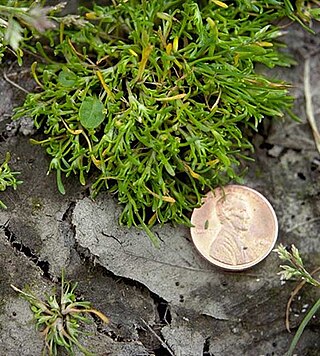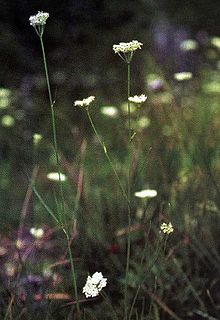
Erigeron parishii is a species of flowering plant in the family Asteraceae known by the common name Parish's fleabane.

Stipa parishii, formerly classified as Achnatherum parishii, is a species of grass known by the common name Parish's needlegrass. The Jepson Manual 2nd edition (2012) reclassified the plant as Stipa parishii var. parishii.

Allium parishii is an uncommon species of wild onion known by the common name Parish's onion. It is native to the Mojave Desert and Sonoran Deserts of California and Arizona. It grows on open dry, rocky slopes at elevations of 900–1,400 m (3,000–4,600 ft).
Atriplex parishii is an uncommon species of saltbush known by the common names Parish's saltbush and Parish's brittlescale. It is native to central and southern California where it can occasionally be found along the immediate coastline, and the Channel Islands. Its distribution extended historically into the western edges of the Mojave Desert and Baja California and it may still exist there.
Chaenactis parishii is a species of flowering plant in the daisy family known by the common name Parish's chaenactis.

Montia howellii is a species of flowering plant in the family Montiaceae known by the common names Howell's miner's lettuce and Howell's montia. It is native to western North America from British Columbia to northern California, where it grows in moist to wet habitat, including vernal pools and meadows. It sometimes grows in shallow standing water such as puddles. The species is known from fossilized seeds recovered from sediments of the Pleistocene Tomales Formation and from a small paleoflora at San Bruno. Further, Daniel Axelrod discussed Montia howellii as one of the biogeographically significant species comprising the Millerton Palaeoflora at Tomales.
Perideridia bacigalupii is an uncommon species of flowering plant in the family Apiaceae known by the common names Mother Lode yampah and Bacigalupi's perideridia. It is endemic to California, where it is known only from the northern and central Sierra Nevada foothills. It is a member of the flora in chaparral and pine woodlands. It is a perennial herb which may exceed 1.5 meters in maximum height, its slender, erect stem growing from tubers. Leaves near the base of the plant have blades up to 40 centimeters long which are divided into many narrow subdivided lobes. Leaves higher on the plant are smaller and less divided. The inflorescence is a compound umbel of many spherical clusters of small white flowers. These yield ribbed, oblong-shaped fruits about half a centimeter long.

Perideridia bolanderi is a species of flowering plant in the family Apiaceae known by the common name Bolander's yampah. It is native to the western United States, where it grows in many types of habitat. It is a perennial herb which may approach one meter in maximum height, its slender, erect stem growing from tubers measuring up to 7 centimeters long. Leaves near the base of the plant have blades up to 20 centimeters long which are divided into many subdivided lobes of various sizes and shapes; the terminal segments are usually lined with teeth. Leaves higher on the plant are smaller and less divided. The inflorescence is a compound umbel of many spherical clusters of small white flowers. These yield ribbed, oblong-shaped fruits about half a centimeter long. The Atsugewi and Miwok of California used the tuberous roots of this plant for food.
Perideridia californica is a species of flowering plant in the family Apiaceae known by the common name California yampah. It is endemic to California, where it is known from the Central Coast Ranges and a section of the Sierra Nevada foothills. It grows in moist soils, often near streams. It is a perennial herb which may approach 1.5 meters in maximum height, its slender, erect stem growing from cylindrical tubers measuring up to 12 centimeters long. Leaves near the base of the plant have blades up to 40 centimeters long which are divided into many flat, narrow, subdivided lobes. Leaves higher on the plant are smaller and less divided. The inflorescence is a compound umbel of many spherical clusters of small white flowers. These yield ribbed, oblong-shaped fruits under a centimeter long.

Perideridia kelloggii is a species of flowering plant in the family Apiaceae known by the common name Kellogg's yampah. It is endemic to California, where it is known from the north and central coasts, the San Francisco Bay Area, and the Sierra Nevada foothills. It grows in grassland habitat, sometimes on serpentine soils. It is a perennial herb which may reach 1.5 meters in maximum height, its slender, erect stem growing from a cluster of long, narrow, fibrous roots each up to 15 centimeters long. Leaves near the base of the plant have blades up to 45 centimeters wide which are divided into many leaflets subdivided into narrow, elongated lobes. The inflorescence is a compound umbel of many spherical clusters of small white flowers. These yield ribbed, oblong-shaped fruits each about half a centimeter long.
Perideridia lemmonii is a species of flowering plant in the family Apiaceae known by the common names Lemmon's yampah and tuni. It is native to the western United States, where it is known from southeastern Oregon, western Nevada, and the mountains of eastern California. It grows in meadows, forests, and other habitat. It is a perennial herb approaching one meter in maximum height, its slender, erect stem growing from usually a single small tuber about 1.5 centimeters long. Leaves near the base of the plant have blades up to 30 centimeters long divided into one or two pairs of leaflets, each of which may be subdivided. The inflorescence is a compound umbel of many spherical clusters of small white flowers. These yield ribbed, round or oblong-shaped fruits each under half a centimeter long.

Perideridia oregana is a species of flowering plant in the family Apiaceae known by the common names Oregon yampah and eppaw. It is native to Oregon and California in the western United States, where it grows in woodland and other habitat. This plant is quite variable in appearance. In general, it is a perennial herb 10 to 90 centimeters tall, its green to waxy-grayish erect stem growing from a cluster of small tubers. Leaves near the base of the plant have blades 3 to 30 centimeters long divided into a variable number of leaflets, which may be subdivided into smaller segments. The inflorescence is a compound umbel of many spherical clusters of small white flowers. These yield ribbed, oblong-shaped fruits 3 to 6 millimeters long.

Sidalcea covillei is an uncommon species of flowering plant in the mallow family known by the common names Owens Valley sidalcea, and Owens Valley checkerbloom. It is endemic to the Owens Valley of Inyo County, California, where it grows on alkali flats and in alkaline meadows and springs. While it is limited to this single valley, it is known from 42 sites there, and several populations are relatively large, but are greatly diminished by historical standards.

Sidalcea hickmanii is a species of flowering plant in the mallow family known generally by the common name chaparral checkerbloom.

Solanum parishii is a species of nightshade known by the common name Parish's nightshade. It is native to western North America from Oregon to Baja California, where it grows in many types of habitat, including maritime and inland chaparral, woodlands, and forests. It is a perennial herb or subshrub producing a branching, ribbed or ridged stem up to about a meter in maximum height. The lance-shaped to nearly oval leaves are up to 7 centimeters long and smooth-edged or somewhat wavy. The inflorescence is an umbel-shaped array of several flowers, each borne on a short pedicel. The flower corolla is around 2 centimeters wide when fully open and is usually purple, but sometimes white. At the center are yellow anthers. The fruit is a berry roughly a centimeter wide.
Tauschia parishii is a species of flowering plant in the carrot family known by the common name Parish's umbrellawort. It is endemic to California.
Trichostema parishii is a species of flowering plant in the mint family known by the common name Parish's bluecurls.

Abutilon parishii is a species of flowering plant in the mallow family known by the common names Parish's Indian mallow and Pima Indian mallow. It is native to Arizona in the United States and Sonora in Mexico.

Perideridia americana is a species of flowering plant in the family Apiaceae known by the common names eastern yampah and wild dill. It has been found in 12 Midwestern United States, and is listed as threatened or endangered in at least 3 of them. In Missouri it is a conservation species of concern.

Acanthoscyphus is a monotypic genus in the family Polygonaceae that contains the single species Acanthoscyphus parishii, which is sometimes called Parish's oxytheca. This species is native and endemic to southern California.














